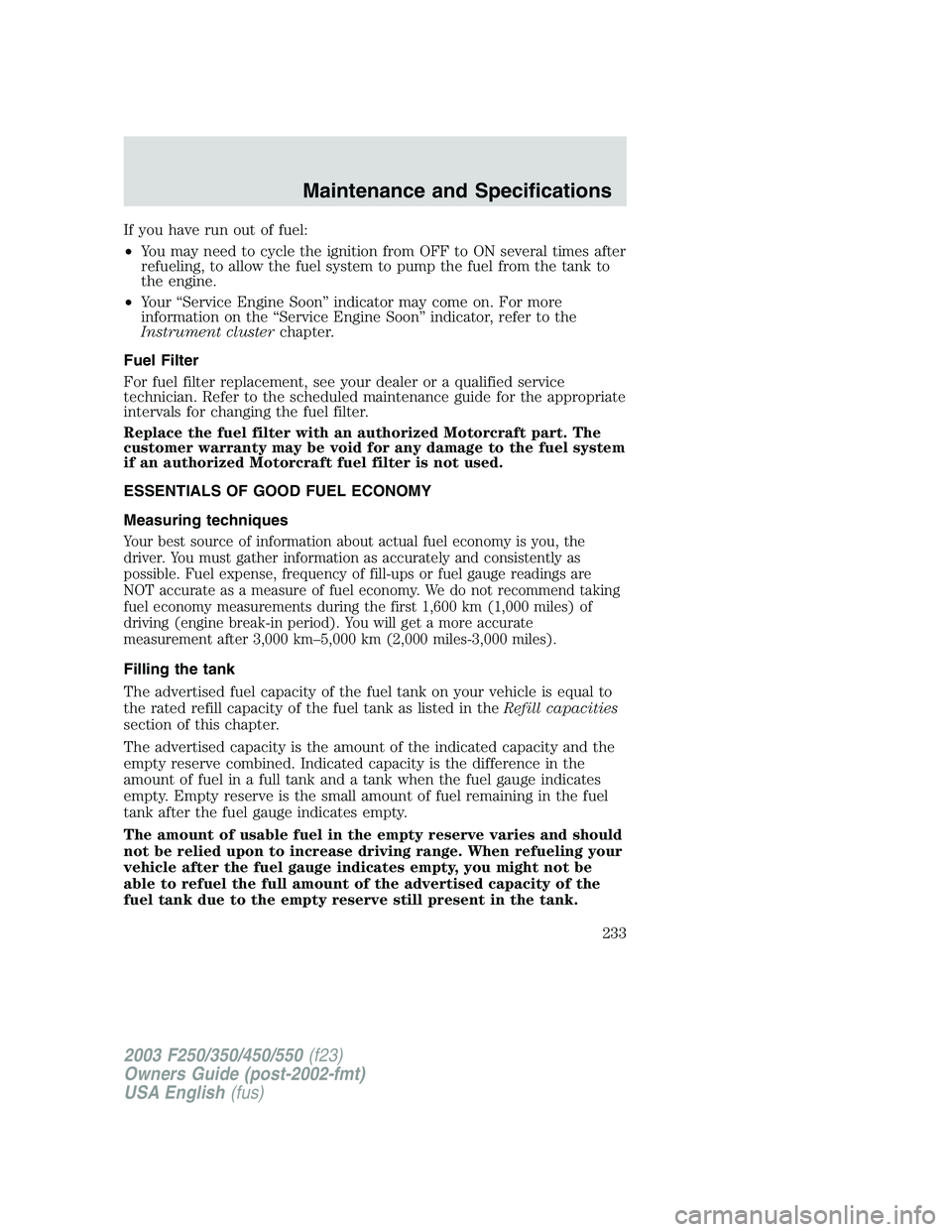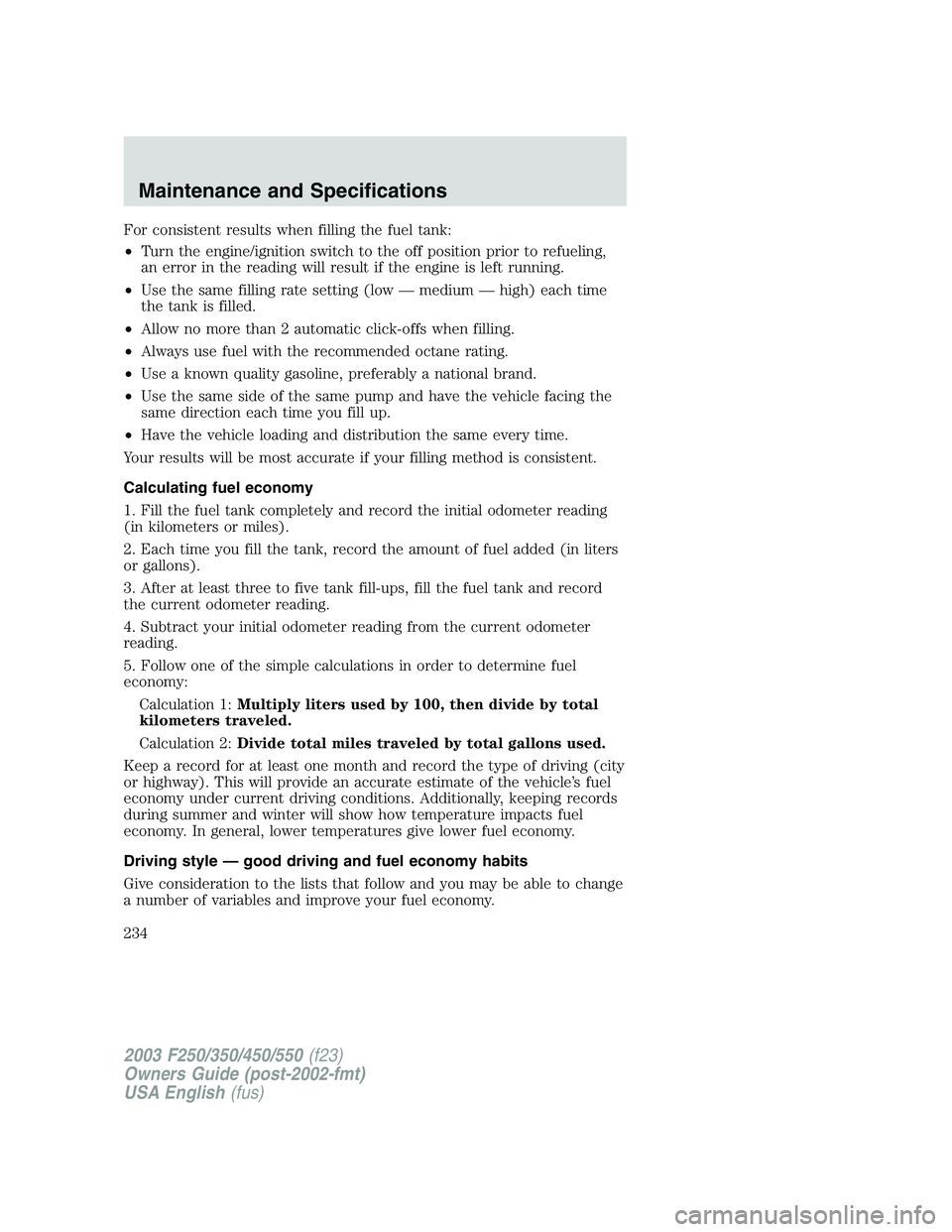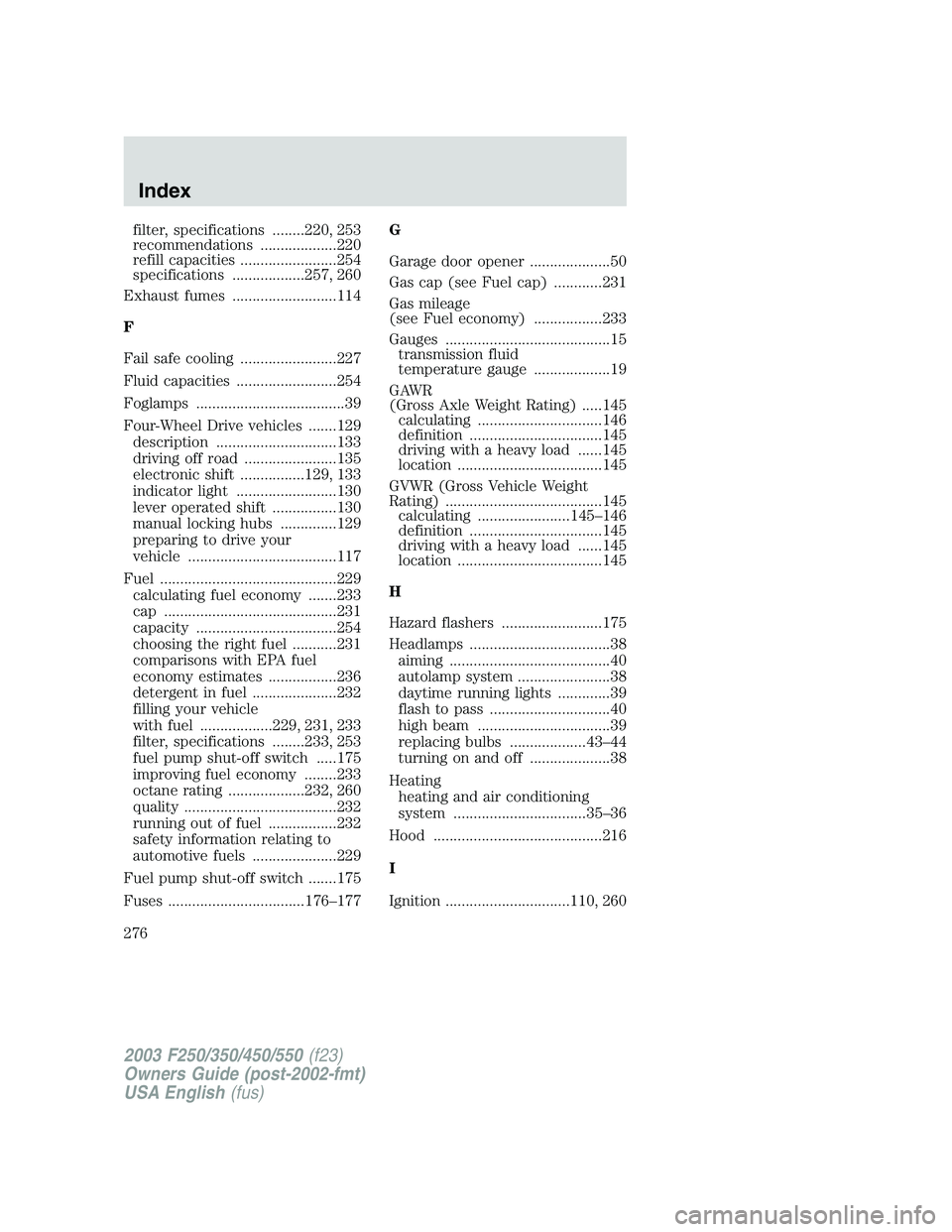Page 233 of 280

If you have run out of fuel:
•You may need to cycle the ignition from OFF to ON several times after
refueling, to allow the fuel system to pump the fuel from the tank to
the engine.
•Your“Service Engine Soon”indicator may come on. For more
information on the“Service Engine Soon”indicator, refer to the
Instrument clusterchapter.
Fuel Filter
For fuel filter replacement, see your dealer or a qualified service
technician. Refer to the scheduled maintenance guide for the appropriate
intervals for changing the fuel filter.
Replace the fuel filter with an authorized Motorcraft part. The
customer warranty may be void for any damage to the fuel system
if an authorized Motorcraft fuel filter is not used.
ESSENTIALS OF GOOD FUEL ECONOMY
Measuring techniques
Your best source of information about actual fuel economy is you, the
driver. You must gather information as accurately and consistently as
possible. Fuel expense, frequency of fill-ups or fuel gauge readings are
NOT accurate as a measure of fuel economy. We do not recommend taking
fuel economy measurements during the first 1,600 km (1,000 miles) of
driving (engine break-in period). You will get a more accurate
measurement after 3,000 km–5,000 km (2,000 miles-3,000 miles).
Filling the tank
The advertised fuel capacity of the fuel tank on your vehicle is equal to
the rated refill capacity of the fuel tank as listed in theRefill capacities
section of this chapter.
The advertised capacity is the amount of the indicated capacity and the
empty reserve combined. Indicated capacity is the difference in the
amount of fuel in a full tank and a tank when the fuel gauge indicates
empty. Empty reserve is the small amount of fuel remaining in the fuel
tank after the fuel gauge indicates empty.
The amount of usable fuel in the empty reserve varies and should
not be relied upon to increase driving range. When refueling your
vehicle after the fuel gauge indicates empty, you might not be
able to refuel the full amount of the advertised capacity of the
fuel tank due to the empty reserve still present in the tank.
2003 F250/350/450/550(f23)
Owners Guide (post-2002-fmt)
USA English(fus)
Maintenance and Specifications
233
Page 234 of 280

For consistent results when filling the fuel tank:
•Turn the engine/ignition switch to the off position prior to refueling,
an error in the reading will result if the engine is left running.
•Use the same filling rate setting (low—medium—high) each time
the tank is filled.
•Allow no more than 2 automatic click-offs when filling.
•Always use fuel with the recommended octane rating.
•Use a known quality gasoline, preferably a national brand.
•Use the same side of the same pump and have the vehicle facing the
same direction each time you fill up.
•Have the vehicle loading and distribution the same every time.
Your results will be most accurate if your filling method is consistent.
Calculating fuel economy
1. Fill the fuel tank completely and record the initial odometer reading
(in kilometers or miles).
2. Each time you fill the tank, record the amount of fuel added (in liters
or gallons).
3. After at least three to five tank fill-ups, fill the fuel tank and record
the current odometer reading.
4. Subtract your initial odometer reading from the current odometer
reading.
5. Follow one of the simple calculations in order to determine fuel
economy:
Calculation 1:Multiply liters used by 100, then divide by total
kilometers traveled.
Calculation 2:Divide total miles traveled by total gallons used.
Keep a record for at least one month and record the type of driving (city
or highway). This will provide an accurate estimate of the vehicle’s fuel
economy under current driving conditions. Additionally, keeping records
during summer and winter will show how temperature impacts fuel
economy. In general, lower temperatures give lower fuel economy.
Driving style—good driving and fuel economy habits
Give consideration to the lists that follow and you may be able to change
a number of variables and improve your fuel economy.
2003 F250/350/450/550(f23)
Owners Guide (post-2002-fmt)
USA English(fus)
Maintenance and Specifications
234
Page 276 of 280

filter, specifications ........220, 253
recommendations ...................220
refill capacities ........................254
specifications ..................257, 260
Exhaust fumes ..........................114
F
Fail safe cooling ........................227
Fluid capacities .........................254
Foglamps .....................................39
Four-Wheel Drive vehicles .......129
description ..............................133
driving off road .......................135
electronic shift ................129, 133
indicator light .........................130
lever operated shift ................130
manual locking hubs ..............129
preparing to drive your
vehicle .....................................117
Fuel ............................................229
calculating fuel economy .......233
cap ...........................................231
capacity ...................................254
choosing the right fuel ...........231
comparisons with EPA fuel
economy estimates .................236
detergent in fuel .....................232
filling your vehicle
with fuel ..................229, 231, 233
filter, specifications ........233, 253
fuel pump shut-off switch .....175
improving fuel economy ........233
octane rating ...................232, 260
quality ......................................232
running out of fuel .................232
safety information relating to
automotive fuels .....................229
Fuel pump shut-off switch .......175
Fuses ..................................176–177G
Garage door opener ....................50
Gas cap (see Fuel cap) ............231
Gas mileage
(see Fuel economy) .................233
Gauges .........................................15
transmission fluid
temperature gauge ...................19
GAWR
(Gross Axle Weight Rating) .....145
calculating ...............................146
definition .................................145
driving with a heavy load ......145
location ....................................145
GVWR (Gross Vehicle Weight
Rating) .......................................145
calculating .......................145–146
definition .................................145
driving with a heavy load ......145
location ....................................145
H
Hazard flashers .........................175
Headlamps ...................................38
aiming ........................................40
autolamp system .......................38
daytime running lights .............39
flash to pass ..............................40
high beam .................................39
replacing bulbs ...................43–44
turning on and off ....................38
Heating
heating and air conditioning
system .................................35–36
Hood ..........................................216
I
Ignition ...............................110, 260
2003 F250/350/450/550(f23)
Owners Guide (post-2002-fmt)
USA English(fus)
Index
276